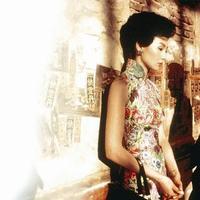#94: 旗袍
#Nr. 94: Cheongsam
#94: Cheongsam
#94: Cheongsam
#94 : Cheongsam
#94: Cheongsam
#94: Cheongsam
#94: Чонгсам
# 94 : Qipao
#94:チャイナドレス
#94: Cheongsam
在 中国 的 电影 和 电视 中 ,我们 常常 可以 看到 穿 旗袍 的 女性 。
in|China|attributive marker|movies|and|television|in|we|often|can|see|wear|cheongsam|attributive marker|women
在|中国|の|映画|と|テレビ|中|私たち|よく|できる|見る|着ている|チーパオ|の|女性
in|Cina|particella possessiva|film|e|televisione|in|noi|spesso|possono|vedere|indossare|qipao|particella possessiva|donne
In Chinese movies and television, we often see women wearing qipaos.
中国の映画やテレビでは、私たちはよくチャイナドレスを着た女性を見ることができます。
Nei film e nella televisione cinese, possiamo spesso vedere donne che indossano il cheongsam.
比如 ,在 《花样年华》 、《2046》 、《色戒》 、《金陵十三钗》 、《一代宗师》 中 ,女主角 穿 旗袍 的 样子 ,都 给人 留下 了 非常 深刻 的 印象 。
||In the Mood for Love|Lust, Caution|Nanjing|||The Grandmaster||the female lead||||||||||
per esempio|in|In the Mood for Love|Lust Caution|The Flowers of War|The Grandmaster|in|protagonista femminile|indossando|qipao|particella possessiva|aspetto|tutti|lasciare impressione|lasciare|particella passata|molto|profonda|particella possessiva|impressione
Por ejemplo, en "El año de las flores", "2046", "El anillo", "La horquilla de los trece" y "El gran maestro", las protagonistas femeninas en cheongsams han dejado una profunda impresión en la gente.
For example, in "In the Mood for Love", "2046", "Lust, Caution", "The Flowers of War", and "The Grandmaster", the female leads wearing qipaos leave a very deep impression.
例えば、『花様年華』、『2046』、『色戒』、『金陵十三釵』、『一代宗師』の中で、女性主人公がチャイナドレスを着ている姿は、非常に深い印象を残します。
Ad esempio, nei film "In the Mood for Love", "2046", "Lust, Caution", "The Flowers of War" e "The Grandmaster", l'aspetto delle protagoniste in cheongsam ha lasciato un'impressione molto profonda.
今天 我们 就 来 说 一 说 旗袍 。
today|we|just|come|talk|one|talk|cheongsam
今日|私たち|ちょうど|来て|話す|一|話す|チーパオ
oggi|noi|proprio|venire|parlare|un|parlare|qipao
Today, let's talk about the qipao.
今日はチャイナドレスについてお話ししましょう。
Oggi parleremo del cheongsam.
旗袍 是 一种 中国 的 传统 服装 。
|||||vêtement traditionnel|
cheongsam|is|one type of|China|attributive marker|traditional|clothing
チャイナドレス|は|一種の|中国の|の|伝統的な|服装
qipao|è|un tipo di|Cina|di|tradizionale|abbigliamento
The qipao is a type of traditional Chinese clothing.
チャイナドレスは中国の伝統的な服装の一つです。
Il qipao è un tipo di abbigliamento tradizionale cinese.
旗袍 最早 出现 在 大约 一百年 以前 , 是 从 清朝 女性 的 服装 变化 而 来 的 。
qipao|||||cento anni|||||||||||
El cheongsam apareció por primera vez hace unos 100 años, y supuso un cambio respecto a la vestimenta de las mujeres de la dinastía Qing.
The qipao first appeared about a hundred years ago and evolved from the clothing of women during the Qing Dynasty.
チャイナドレスは約100年前に最初に登場し、清朝の女性の服装の変化から来ています。
Il qipao è apparso per la prima volta circa cento anni fa, ed è derivato dall'evoluzione dell'abbigliamento femminile della dinastia Qing.
清朝 的 皇室 贵族 ,也 叫做 “旗人” 。
Qing Dynasty|attributive marker|royal family|nobility|also|called|banner people
清朝|の|皇室|貴族|も|呼ばれる|“旗人
dinastia Qing|particella possessiva|imperiale|nobiltà|anche|chiamato|Qiren
La aristocracia imperial de la dinastía Qing, también conocida como los "Estandartes".
The royal nobility of the Qing Dynasty were also known as 'Banner People'.
清朝の皇室貴族は「旗人」とも呼ばれています。
L'aristocrazia imperiale della dinastia Qing, chiamata anche "Qiren".
“袍 ”在 汉语 中 ,指 的 是 长长 的 衣服 。
robe|in|Chinese|among|refer to|attributive marker|is|long|attributive marker|clothes
袍|在|汉语|中|指|的|是|长长|的|衣服
tunica|in|cinese|dentro|si riferisce a|particella possessiva|è|lungo|particella descrittiva|vestito
'Pao' in Chinese refers to a long garment.
「袍」は中国語で長い服を指します。
"Pao" in cinese si riferisce a un vestito lungo.
因为 是 “旗人” 女性 所 穿 的 “长袍” ,所以 就 有 了 “旗袍” 这个 名字 。
because|is|banner people|women|that|wear|attributive marker|long gown|so|then|have|past tense marker|cheongsam|this|name
なぜなら|は|「旗人」|女性|が|着|の|「長袍」|だから|ちょうど|存在する|過去形のマーカー|「旗袍」|この|名前
perché|è|Qí rén|donne|che|indossano|particella possessiva|cháng páo|quindi|allora|ha|particella passata|qipao|questo|nome
El nombre de "cheongsam" surgió porque era una "bata" que llevaban las mujeres "cheongsam".
Since it was a 'long gown' worn by 'Banner' women, it was named 'qipao'.
「旗人」の女性が着る「長袍」なので、「旗袍」という名前が付けられました。
Perché è il "qipao" indossato dalle donne "banner", è nato il nome "qipao".
旗袍 刚 开始 流行 是 在 民国 时期 。
cheongsam|just|start|popular|is|in|Republic of China|period
チャイナドレス|ちょうど|始まった|流行|は|に|民国|時代
qipao|appena|iniziato|popolare|è|durante|Repubblica di Cina|periodo
The qipao began to gain popularity during the Republic of China period.
チャイナドレスが最初に流行したのは民国時代です。
Il qipao ha iniziato a diffondersi durante il periodo della Repubblica di Cina.
这个 时期 ,也 是 中国 的 “女权运动” 开始 的 时期 。
this|period|also|is|China|attributive marker|women's rights movement|began|attributive marker|period
この|時期|も|は|中国|の|女権運動|始まる|の|時期
questo|periodo|anche|è|Cina|particella possessiva|movimento femminista|inizio|particella possessiva|periodo
This period also marks the beginning of the "women's rights movement" in China.
この時期は、中国の「フェミニズム運動」が始まった時期でもあります。
Questo periodo è anche l'inizio del movimento per i diritti delle donne in Cina.
女 人 们 希 望 拥 有 和 男 人 一 样 的 权 利 和 地 位 。
woman|people|plural marker|hope|hope|to have||and|man|people|||attributive marker|||and||position
女|人|複数形|||||と|男|人|||の|権利|利|と||
donna|persone|suffisso plurale|希||godere||e|uomo|persone|||particella possessiva|||e||
Las mujeres quieren tener los mismos derechos y el mismo estatus que los hombres.
Les femmes veulent avoir les mêmes droits et le même statut que les hommes.
Women hoped to have the same rights and status as men.
女性たちは男性と同じ権利と地位を持ちたいと望んでいました。
Le donne speravano di avere gli stessi diritti e status degli uomini.
旗袍 ,这种 富有 个性 的 女性 服装 首先 出现 在 中国 最 时尚 的 城市 ,上海 。
cheongsam|this kind of|rich in|personality|attributive marker|women's|clothing|first|appear|in|China|most|fashionable|attributive marker|city|Shanghai
チャイナドレス|この|豊かな|個性|の|女性|服|最初に|現れた|で|中国|最も|ファッショナブルな|の|都市|上海
qipao|questo|ricco di|personalità|particella possessiva|donna|abbigliamento|prima|apparire|in|Cina|più|alla moda|particella possessiva|città|Shanghai
El cheongsam, prenda distintiva de la indumentaria femenina, apareció por primera vez en la ciudad más de moda de China, Shanghai.
Le cheongsam, vêtement féminin individualiste, est apparu pour la première fois dans la ville la plus à la mode de Chine, Shanghai.
The qipao, a distinctive women's garment, first appeared in China's most fashionable city, Shanghai.
チャイナドレス、この個性的な女性の服装は、最初に中国で最もファッショナブルな都市、上海に登場しました。
Il qipao, questo abbigliamento femminile ricco di personalità, è apparso per la prima volta nella città più alla moda della Cina, Shanghai.
然后 在 其他 大 城市 流行 起来 。
then|in|other|big|city|become popular|up
その後|で|他の|大きな|都市|流行|始める
poi|in|altri|grande|città|popolare|cominciare
It then became popular in other major cities.
その後、他の大都市でも流行するようになりました。
Poi è diventato popolare in altre grandi città.
慢慢地 ,旗袍 就 变成 了 中国 女性 最 重要 的 正装 。
slowly|adverb marker|cheongsam|then|become|past tense marker|China|women|most|important|attributive marker
ゆっくりと|チャイナドレス|すぐに|変わった|過去形のマーカー|中国の|女性|最も|重要な|所有格助詞|正装
lentamente|qipao|già|diventato|particella passata|Cina|donne|più|importante|particella possessiva|abbigliamento formale
Gradually, the qipao became the most important formal attire for Chinese women.
徐々に、チャイナドレスは中国女性にとって最も重要な正装となりました。
Piano piano, il qipao è diventato l'abito formale più importante per le donne cinesi.
不管 是 女 明星 ,女 老师 ,女 学生 ,还是 家庭 主妇 ,都 喜欢 穿 旗袍 。
no matter|is|female|star|female|teacher|female|student|or|family|housewife|all|like|wear|qipao
どんなに|は|女|スター|女|教師|女|学生|または|家庭|主婦|みんな|好き|着る|チーパオ
non importa|è|femminile|stella|femminile|insegnante|femminile|studentessa|oppure|famiglia|casalinga|tutte|piace|indossare|qipao
Regardless of whether they are female celebrities, female teachers, female students, or housewives, they all like to wear qipaos.
女優、女教師、女子学生、そして主婦に関わらず、皆がチャイナドレスを着るのが好きです。
Non importa se sono star femminili, insegnanti, studentesse o casalinghe, tutte amano indossare il qipao.
那时候 的 旗袍 ,和 现在 的 旗袍 不太 一样 。
that|time|attributive marker|cheongsam|and|now|attributive marker|cheongsam|not
あの時|の|チーパオ|と|現在|の|チーパオ|あまり|同じではない
allora|particella possessiva|abito tradizionale|e|adesso|particella possessiva|abito tradizionale|non troppo|uguale
The qipaos from that time were quite different from the qipaos of today.
当時のチャイナドレスは、今のチャイナドレスとはあまり似ていません。
A quel tempo, il qipao era diverso da quello attuale.
最早 的 旗袍 很 长 ,领子 比较 高 ,还 带有 袖子 。
earliest|attributive marker|cheongsam|very|long|collar|relatively|high|also|has|sleeves
最初の|の|チャイナドレス|とても|長い|襟|比較的|高い|まだ|持っている|袖
più antico|particella possessiva|qipao|molto|lungo|colletto|relativamente|alto|anche|avere|maniche
Los primeros cheongsams eran muy largos, con cuellos y mangas altos.
Les premiers cheongsams étaient longs, avec des cols et des manches hautes.
The earliest qipaos were very long, had higher collars, and also had sleeves.
最初のチャイナドレスはとても長く、襟が高く、袖もありました。
I primi qipao erano molto lunghi, con colli piuttosto alti e con maniche.
后来 ,这些 部分 都 被 简化 了 。
later|these|parts|all|were|simplified|emphasis marker
後で|これらの|部分|すべて|受動態の助詞|簡略化|完了を示す助詞
poi|questi|parti|tutte|essere|semplificate|particella di completamento
Later, these parts were simplified.
その後、これらの部分はすべて簡略化されました。
Successivamente, queste parti furono semplificate.
这样 ,旗袍 穿 起来 就 更 舒服 ,看上去 也 更加 妩媚 。
this way|cheongsam|wear|up|then|more|comfortable|look|also|even more|charming
こう|チャイナドレス|着る|始める|それなら|さらに|快適|見た目|も|より一層|魅力的
così|qipao|indossare|forma|allora|più|comodo|sembra|anche|ancora più|affascinante
Esto hace que el cheongsam sea más cómodo de llevar y más femenino a la vista.
De cette manière, le cheongsam sera plus confortable à porter et plus charmant.
As a result, qipaos became more comfortable to wear and looked more charming.
その結果、チャイナドレスはより快適に着られ、見た目もより魅力的になりました。
In questo modo, il qipao è più comodo da indossare e appare anche più affascinante.
旗袍 在 中国 传统 服装 的 基础 上 ,加入 了 的 西方 服装 的 特点 。
||||||||added||||||
チャイナドレス|に|中国|伝統的な|服装|の|基礎|上に|加えられた|過去形のマーカー|の|西洋|服装|の|特徴
qipao|in|Cina|tradizionale|abbigliamento|particella possessiva|base|su|aggiunto|particella passata|particella possessiva|occidentale|abbigliamento|particella possessiva|caratteristiche
El cheongsam es un traje tradicional chino con un toque occidental.
Le cheongsam s'inspire des vêtements traditionnels chinois et intègre les caractéristiques des vêtements occidentaux.
Trên cơ sở trang phục truyền thống của Trung Quốc, Qipao đã thêm các đặc điểm của trang phục phương Tây.
The qipao incorporates characteristics of Western clothing based on traditional Chinese attire.
チャイナドレスは中国の伝統的な服装の基礎の上に、西洋の服装の特徴を取り入れています。
Il qipao, sulla base dell'abbigliamento tradizionale cinese, ha incorporato caratteristiche dell'abbigliamento occidentale.
传统 的 中国 服装 ,一般 比较 宽大 、保守 。
traditional|attributive marker|China|clothing|generally|relatively|loose|conservative
伝統的な|の|中国|服装|一般的に|比較的に|ゆったりした|保守的な
tradizionale|particella possessiva|Cina|abbigliamento|generalmente|relativamente|largo|conservativo
La vestimenta tradicional china suele ser generosa y conservadora.
Les vêtements traditionnels chinois sont généralement larges et conservateurs.
Traditional Chinese clothing is generally looser and more conservative.
伝統的な中国の服装は、一般的に比較的ゆったりとしていて保守的です。
L'abbigliamento tradizionale cinese è generalmente piuttosto ampio e conservatore.
而 旗袍 更加 体现 了 女性 的 线条 美 ,更加 现代 。
but|cheongsam|even more|reflect|past tense marker|female|attributive marker|lines|beauty|even more|modern
しかし|チャイナドレス|さらに|体現する|過去形のマーカー|女性|所有格助詞|線|美しさ|さらに|現代的
e|qipao|ancora di più|riflette|particella passata|femminile|particella possessiva|linee|bellezza|ancora di più|moderno
El cheongsam es más moderno y refleja la belleza lineal de la mujer.
Le cheongsam est plus moderne et incarne la beauté des lignes féminines.
In contrast, the qipao better reflects the beauty of women's curves and is more modern.
一方、チャイナドレスは女性のラインの美しさをより強調し、より現代的です。
Il qipao, invece, mette maggiormente in risalto la bellezza delle linee femminili ed è più moderno.
同时 ,旗袍 也 保留 了 中国 传统 服装 的 特点 。
at the same time|cheongsam|also|retain|past tense marker|China|traditional|clothing|attributive marker|characteristics
同時|チャイナドレス|も|保持する|過去形のマーカー|中国|伝統的な|服装|の|特徴
allo stesso tempo|qipao|anche|mantenere|particella passata|Cina|tradizionale|abbigliamento|particella possessiva|caratteristiche
At the same time, the qipao also retains features of traditional Chinese clothing.
同時に、チャイナドレスは中国の伝統的な服装の特徴も保持しています。
Allo stesso tempo, il qipao conserva anche le caratteristiche dell'abbigliamento tradizionale cinese.
比如 衣服 上 的 花纹 、扣子 、边饰 和 领子 等 地方 ,都 运用 了 传统 中国 风格 的 造型 。
for example|clothes|on|attributive marker|patterns|buttons|trims|and|collar|etc|places|all|use|past tense marker|traditional|Chinese|style|attributive marker|shapes
例えば|衣服|上|の|模様|ボタン|縁飾り|と|襟|等|場所|すべて|使用|過去形のマーカー|伝統的な|中国|スタイル|の|形状
per esempio|abbigliamento|su|particella possessiva|motivo|bottoni|decorazioni|e|colletto|eccetera|luoghi|tutti|applicato|particella passata|tradizionale|Cina|stile|particella possessiva|forme
Por ejemplo, los estampados, botones, adornos y cuellos de los vestidos siguen el estilo tradicional chino.
Par exemple, les motifs, les boutons, les bordures et les cols des vêtements sont modelés dans le style chinois traditionnel.
For example, the patterns, buttons, trims, and collars on the clothing all utilize traditional Chinese style designs.
例えば、衣服の上の模様、ボタン、縁飾り、襟などの部分には、伝統的な中国スタイルのデザインが使われています。
Ad esempio, i motivi, i bottoni, i bordi e il colletto dei vestiti utilizzano forme di stile tradizionale cinese.
旗袍 的 出现 ,说明 了 人们 审美 的 转变 。
cheongsam|attributive marker|appearance|indicate|past tense marker|people|aesthetics|attributive marker|change
チャイナドレス|の|出現|説明する|過去形を示す助詞|人々|美的感覚|の|変化
qipao|particella possessiva|apparizione|dimostra|particella passata|persone|estetica|particella possessiva|cambiamento
La aparición del cheongsam ilustra un cambio estético.
L'apparition du cheongsam illustre un changement d'esthétique.
The emergence of the qipao indicates a transformation in people's aesthetic values.
チャイナドレスの出現は、人々の美的感覚の変化を示しています。
L'emergere del qipao indica un cambiamento nel gusto estetico delle persone.
旗袍 的 美 ,是 一种 传统 和 现代 结合 而 形成 的 美 。
cheongsam|attributive marker|beauty|is|one kind of|tradition|and|modern|combination|and|form|attributive marker|beauty
チャイナドレス|の|美しさ|は|一種の|伝統的な|と|現代|結合|そして|形成された|の|美
qipao|di|bellezza|è|una|tradizionale|e|moderno|combinazione|e|formata|di|bellezza
La belleza del cheongsam es una combinación de tradición y modernidad.
La beauté du cheongsam est une combinaison de tradition et de modernité.
The beauty of the qipao is a beauty formed by the combination of tradition and modernity.
チャイナドレスの美しさは、伝統と現代が融合して形成された美です。
La bellezza del qipao è una bellezza che si forma dalla combinazione di tradizione e modernità.
现在 ,旗袍 仍然 是 非常 重要 的 中国式 礼服 。
now|cheongsam|still|is|very|important|attributive marker|Chinese-style|formal dress
現在|チーパオ|依然|は|非常|重要|の|中国式|ドレス
adesso|qipao|ancora|è|molto|importante|particella possessiva|stile cinese|abito formale
De nos jours, le cheongsam reste un vêtement chinois très important.
Today, the qipao is still a very important type of Chinese formal wear.
現在、チャイナドレスは非常に重要な中国式の礼服です。
Oggi, il qipao è ancora un abito formale cinese molto importante.
不 仅 是 中国 的 女性 ,许多 其他 国家 的 女性 ,也 很 喜欢 旗袍 。
not only|is|China|attributive marker|women|many|other|countries|attributive marker|women|also|very|like|cheongsam|
だけでなく|は|中国|の|女性|多くの|他の|国|の|女性|も|とても|好き|チャイナドレス|
non|solo|è|Cina|particella possessiva|donne|molte|altri|paesi|particella possessiva|donne|anche|molto|piacciono|qipao
Not only Chinese women, but many women from other countries also love the qipao.
中国の女性だけでなく、多くの他の国の女性もチャイナドレスが大好きです。
Non solo le donne cinesi, ma anche molte donne di altri paesi amano molto il qipao.
许多 著名 的 好莱坞 女 明星 ,也 喜欢 穿着 华丽 的 旗袍 ,走上 红 地毯 。
many|famous|attributive marker|Hollywood|female|star|also|like|wearing|glamorous|attributive marker|cheongsam|walk on|red|carpet
多くの|有名な|の|ハリウッド|女性|スター|も|好き|着ている|豪華な|の|チーパオ|歩いて上がる|赤い|カーペット
molti|famosi|particella possessiva|Hollywood|donne|stelle|anche|piace|indossare|elegante|particella possessiva|qipao|camminare su|rosso|tappeto
A muchas famosas actrices de Hollywood también les gustaba pasear por la alfombra roja con preciosos cheongsams.
Many famous Hollywood actresses also enjoy wearing glamorous qipaos on the red carpet.
多くの有名なハリウッド女優も華やかなチャイナドレスを着て、レッドカーペットを歩くのが好きです。
Molte famose attrici di Hollywood amano indossare splendidi qipao mentre sfilano sul tappeto rosso.
在 中国 ,新娘 们 结婚 的 时候 ,一般 至少 要 换 两件 礼服 :一件 是 西式 的 白色 婚纱 ,另外 一件 就是 中式 的 旗袍 。
at|China|bride|plural marker|get married|attributive marker|time|generally|at least|need|change|two pieces|wedding dress|one piece|is|Western-style|attributive marker|white|wedding dress|another|one piece|is|Chinese-style|attributive marker|qipao
在|中国|新娘|们|結婚|の|時間|一般|少なくとも|必要|交換する|二着|ドレス|一着|は|西洋式|の|白い|ウェディングドレス|もう一つ|一着|それは|中華式|の|チーパオ
in|Cina|sposa|particella plurale|matrimonio|particella possessiva|tempo|generalmente|almeno|deve|cambiare|due|abiti|una|è|stile occidentale|particella possessiva|bianco|abito da sposa|altro|una|è|stile cinese|particella possessiva|qipao
En China, cuando una novia se casa, suele ponerse al menos dos vestidos: un traje de novia occidental blanco y un cheongsam chino.
In China, brides generally need to change into at least two dresses when getting married: one is a Western-style white wedding gown, and the other is a Chinese-style qipao.
中国では、新婦は結婚する際に一般的に少なくとも2着のドレスを着替えます:1着は西洋式の白いウェディングドレス、もう1着は中国式の旗袍です。
In Cina, le spose di solito indossano almeno due abiti da cerimonia per il matrimonio: uno è un abito da sposa bianco in stile occidentale, l'altro è un qipao in stile cinese.
SENT_CWT:AsVK4RNK=4.11 PAR_TRANS:gpt-4o-mini=2.69 SENT_CWT:AsVK4RNK=6.12 PAR_TRANS:gpt-4o-mini=3.12 SENT_CWT:9r5R65gX=6.88 PAR_TRANS:gpt-4o-mini=2.92 SENT_CWT:9r5R65gX=6.72 PAR_TRANS:gpt-4o-mini=8.79
en:AsVK4RNK en:AsVK4RNK ja:9r5R65gX it:unknowd
openai.2025-02-07
ai_request(all=39 err=0.00%) translation(all=31 err=0.00%) cwt(all=372 err=7.53%)

